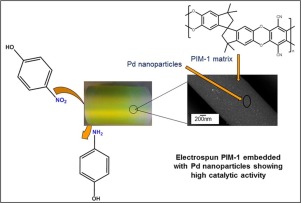Applied Catalysis A: General ( IF 5.5 ) Pub Date : 2018-02-06 , DOI: 10.1016/j.apcata.2018.02.004 Karabi Halder , Gisela Bengtson , Volkan Filiz , Volker Abetz

|
Microfibers of the first so-called polymer of intrinsic microporosity (PIM-1) were prepared by electrospinning 10 wt.% PIM-1 in tetrachloroethane and used as immobilized supports for catalytic reactions. Solutions with varied concentrations of palladium diacetate (PdAc2) were coated on electrospun PIM-1 to show that PIM-1 is a superior catalyst supporting material with a high surface per weight ratio. Palladium (Pd) nanoparticles (NPs) were produced via the reduction of the PdAc2 with ethanol followed by subsequent thermal treatment for durably fixing the NPs on the fibers. A comparison of the catalytic activity of PIM-1 supported PdNPs was made with that of similarly produced electrospun nanofibers of polyacrylonitrile (PAN) and polyimide (6FDA-6FpDA) with catalytic PdNPs.
The morphology of the electrospun fibers and the distribution of the Pd nanoparticles on the outer surface of the fibers were determined by scanning electron microscopy (SEM). Transmission electron microscopy (TEM) analysis of the cross section of the fibers showed the distribution of PdNPs across the fiber with a slight excess on the outer surface of the fibers. The nanoparticles (NPs) supported by the electrospun polymers catalyzed the reduction of different aromatic nitro compounds to their corresponding amino derivatives. The kinetics of the reduction reactions were monitored by ultraviolet-visible (UV-Vis) spectroscopy. Results showed that the PdNPs supported by electrospun PIM-1 fiber possessed high activity in the reduction reaction with an only slight dependence on the fiber diameter in the case of p-nitrophenol, while in the case of the dinitro compounds the dependence of the kinetics on the fiber diameter was more pronounced. The catalytic tests on two dinitro compounds proved the higher sorption of PIM-1 for p-nitrophenol is responsible for the higher catalytic activity of PIM-1 based catalytic nanofiber mats. These results clearly show that the catalytic activity of the PIM-1 fiber mats is higher compared to the fiber mats from PAN or 6FDA-6FpDA in the case of small reactants, which is mainly due to the fact that the PdNPs are also formed within the microporous PIM-1 fibers, while this is not the case for the other more dense fibers, where the catalytic particles are located only on the outer surface.
中文翻译:

静电纺丝PIM-1负载的催化活性(Pd)纳米颗粒:在某些芳香族硝基化合物的还原反应中测试的聚合物的吸附能力的影响
第一种所谓的具有固有微孔性的聚合物(PIM-1)的微纤维是通过在四氯乙烷中静电纺丝10%(重量)的PIM-1制备的,并用作催化反应的固定载体。将具有不同浓度的二乙酸钯(PdAc 2)的溶液涂覆在电纺PIM-1上,以显示PIM-1是一种具有高表面单位重量比的优异催化剂载体材料。钯(Pd)纳米粒子(NPs)的制备方法是:用乙醇还原PdAc 2,然后进行热处理,以将NPs持久地固定在纤维上。将PIM-1负载的PdNPs与具有催化PdNPs的类似生产的聚丙烯腈(PAN)和聚酰亚胺(6FDA-6FpDA)的电纺纳米纤维的催化活性进行了比较。
通过扫描电子显微镜(SEM)确定电纺纤维的形态和Pd纳米颗粒在纤维外表面上的分布。纤维横截面的透射电子显微镜(TEM)分析表明,PdNPs在纤维上的分布略有过量,在纤维的外表面上。由电纺聚合物支撑的纳米颗粒(NPs)催化了不同的芳族硝基化合物还原成其相应的氨基衍生物。通过紫外可见(UV-Vis)光谱法监测还原反应的动力学。结果表明,电纺丝PIM-1纤维负载的PdNPs在还原反应中具有高活性,在p情况下仅对纤维直径有很小的依赖性-硝基苯酚,而在二硝基化合物的情况下,动力学对纤维直径的依赖性更加明显。对两种二硝基化合物的催化测试证明,PIM-1对对硝基苯酚的吸附较高,这是基于PIM-1的催化纳米纤维垫具有较高催化活性的原因。这些结果清楚地表明,在小反应物的情况下,PIM-1纤维毡的催化活性要比PAN或6FDA-6FpDA的纤维毡高,这主要是由于PdNPs也在催化剂内部形成。微孔PIM-1纤维,而其他更致密的纤维则不是这种情况,其中催化颗粒仅位于外表面。


























 京公网安备 11010802027423号
京公网安备 11010802027423号